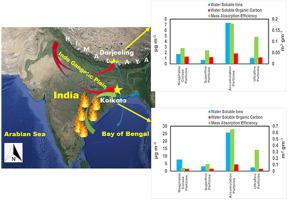Atmospheric Environment ( IF 4.2 ) Pub Date : 2021-04-10 , DOI: 10.1016/j.atmosenv.2021.118398 Abhinandan Ghosh , Anil Patel , Neeraj Rastogi , Sudhir Kumar Sharma , Tuhin Kumar Mandal , Abhijit Chatterjee

|
A study has been conducted focusing on the chemical and optical characterization of water soluble inorganic and organic components of aerosols at different sizes, over a high altitude Himalayan station, Darjeeling (27.1° N and 88.15° E, 2200 m amsl) and a tropical urban metropolis, Kolkata (22.5° N, 88.3° E, ~6 m amsl) for two-year long period (March 2016–February 2018). It was observed that local meteorology and long range transport of pollution plumes have played the pivotal role in governing the temporal variation of the mass distribution and concentration of aerosols and its various components over both the sites. The aerosol mass-size distributions were found to be bimodal in nature with the relative dominance of accumulation mode (0.1–1.0 μm) over coarse mode (1.8–10 μm) over both the stations, indicating dominance of the anthropogenic emissions. Among the size classes, accumulation mode aerosols alone contributed 55–75% over Darjeeling and 40–60% over Kolkata to PM10. The coarse mode aerosols were mainly consisted of primary inorganic species over Kolkata and water soluble organic carbons (WSOC) over Darjeeling whereas the fine mode aerosols (accumulation: 0.1–1.0 μm) were primarily composed of the secondary inorganic aerosols for both the stations. Irrespective of the seasons and stations, SO42− and NH4+ exhibited peaks in the mass-size distribution at 1.0–0.1 μm whereas that of NO3− varied with the seasons. The photochemical oxidation and the aqueous phase oxidation of SO2 (g) were the pathways for SO42− formation over Darjeeling whereas the later dominated over Kolkata. Concentration weighted trajectory (CWT) model has revealed that the secondary inorganic aerosols and WSOC were local/regional in origin over Kolkata megacity whereas Darjeeling was influenced by mixed sources. The accumulation mode aerosols were found to be the highest light absorbing over both the stations irrespective of the seasons. Over Darjeeling, the absorption coefficient (babs_365) and the mass absorption efficiency (MAE) of WSOC were maximum for local biomass burning aerosols than the transported plumes whereas those over Kolkata were maximum for transported biomass burning plumes from Eastern Ghats.
中文翻译:

印度东部喜马拉雅山和热带城市都市上按大小隔离的气溶胶:化学表征,光吸收,气象作用和远距离运输
进行了一项研究,重点研究了在大吉岭喜马拉雅站,北大吉岭(北纬27.1°和东经88.15°,2200 m amsl)和热带城市不同高度的气溶胶的水溶性无机和有机成分的化学和光学特征。大都会加尔各答(22.5°N,88.3°E,〜6 m amsl),为期两年(2016年3月至2018年2月)。据观察,当地气象学和污染羽流的长距离运输在控制两个地点气溶胶及其各种成分的质量分布和浓度的时间变化方面起着关键作用。发现两个站点的气溶胶质量尺寸分布本质上都是双峰的,相对于粗模式(1.8-10μm)而言,累积模式的相对优势为(0.1-1.0μm),表明人为排放占主导地位。在尺寸等级中,仅累积模式气溶胶对大吉岭的贡献为55-75%,对加尔各答的贡献为40-60%10。粗模式气溶胶主要由加尔各答上方的主要无机物和大吉岭上方的水溶性有机碳(WSOC)组成,而精细模式气溶胶(累积量:0.1–1.0μm)主要由两个站点的次要无机气溶胶组成。不论季节和站,SO的4 2-和NH 4 +中在1.0-0.1微米,而该NO的质量大小分布展出峰3 -变化随季节。SO 2(g)的光化学氧化和水相氧化是SO 4 2-的途径在大吉岭形成,而后来在加尔各答占主导地位。浓度加权轨迹(CWT)模型表明,二级无机气溶胶和WSOC起源于加尔各答特大城市的局部/区域,而大吉岭则受混合源的影响。不论季节如何,在两个站上都发现累积模式的气溶胶是最高的光吸收量。在大吉岭上空,局部生物质燃烧气溶胶的WSOC的吸收系数(b abs_365)和质量吸收效率(MAE)高于运输烟羽,而加尔各答上方的那些则是来自东高止山脉的运输生物质燃烧烟气的最大值。











































 京公网安备 11010802027423号
京公网安备 11010802027423号